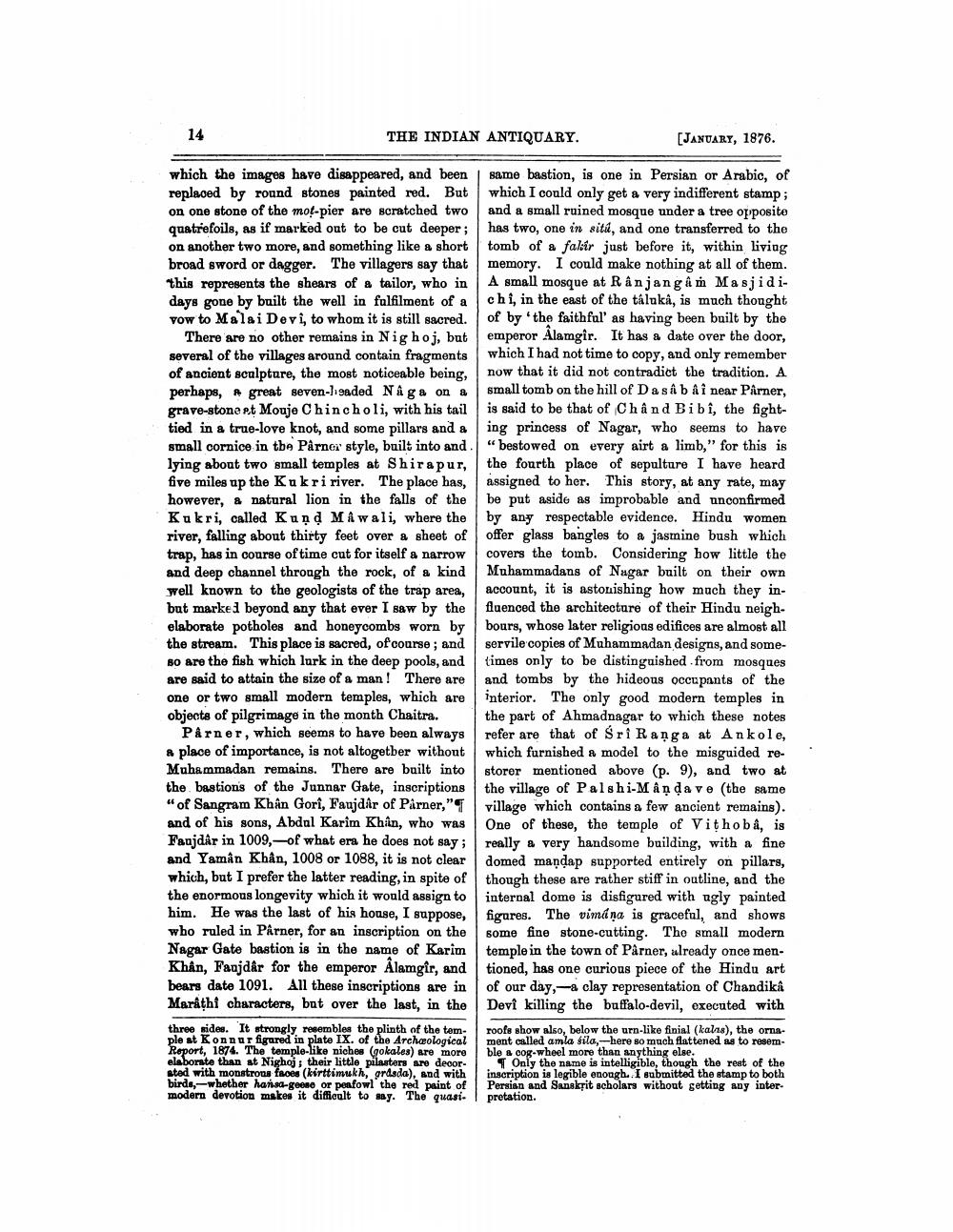________________
14
THE INDIAN ANTIQUARY.
[JANUARY, 1876.
"
same bastion, is one in Persian or Arabic, of which I could only get a very indifferent stamp ; and a small ruined mosque under a tree opposite has two, one in situ, and one transferred to the tomb of a fakir just before it, within living memory. I could make nothing at all of them. A small mosque at Rânjang âm Masjidichi, in the east of the taluka, is much thought of by the faithful' as having been built by the emperor Alamgir. It has a date over the door, which I had not time to copy, and only remember now that it did not contradict the tradition. A small tomb on the hill of Da sâb âî near Pârner, is said to be that of Chand Bibi, the fighting princess of Nagar, who seems to have "bestowed on every airt a limb," for this is the fourth place of sepulture I have heard assigned to her. This story, at any rate, may be put aside as improbable and unconfirmed by any respectable evidence. Hindu women offer glass bangles to a jasmine bush which covers the tomb. Considering how little the Muhammadans of Nagar built on their own account, it is astonishing how much they influenced the architecture of their Hindu neighbours, whose later religious edifices are almost all servile copies of Muhammadan designs, and sometimes only to be distinguished from mosques and tombs by the hideous occupants of the interior. The only good modern temples in the part of Ahmadnagar to which these notes refer are that of Sri Ranga at Ankole, which furnished a model to the misguided restorer mentioned above (p. 9), and two at
which the images have disappeared, and been replaced by round stones painted red. But on one stone of the mot-pier are scratched two quatrefoils, as if marked out to be cut deeper; on another two more, and something like a short broad sword or dagger. The villagers say that this represents the shears of a tailor, who in days gone by built the well in fulfilment of a vow to Malai Devi, to whom it is still sacred. There are no other remains in Nig hoj, but several of the villages around contain fragments of ancient sculpture, the most noticeable being, perhaps, a great seven-headed Någa on a grave-stone at Mouje Chincholi, with his tail tied in a true-love knot, and some pillars and a small cornice in the Pârner style, built into and. lying about two small temples at Shirapur, five miles up the Kukri river. The place has, however, a natural lion in the falls of the Kukri, called Kund Mawali, where the river, falling about thirty feet over a sheet of trap, has in course of time cut for itself a narrow and deep channel through the rock, of a kind well known to the geologists of the trap area, but marked beyond any that ever I saw by the elaborate potholes and honeycombs worn by the stream. This place is sacred, of course; and so are the fish which lurk in the deep pools, and are said to attain the size of a man! There are one or two small modern temples, which are objects of pilgrimage in the month Chaitra.
Pârner, which seems to have been always a place of importance, is not altogether without Muhammadan remains. There are built into the bastions of the Junnar Gate, inscriptions the village of Palshi-Mandave (the same "of Sangram Khân Gori, Faujdâr of Pârner," and of his sons, Abdul Karim Khân, who was Fanjdar in 1009,-of what era he does not say; and Yamân Khân, 1008 or 1088, it is not clear which, but I prefer the latter reading, in spite of the enormous longevity which it would assign to him. He was the last of his house, I suppose, who ruled in Pârner, for an inscription on the Nagar Gate bastion is in the name of Karim Khân, Faujdår for the emperor Alamgir, and bears date 1091. All these inscriptions are in Marathi characters, but over the last, in the
village which contains a few ancient remains). One of these, the temple of Vithoba, is really a very handsome building, with a fine domed mandap supported entirely on pillars, though these are rather stiff in outline, and the internal dome is disfigured with ugly painted figures. The vimana is graceful, and shows some fine stone-cutting. The small modern temple in the town of Pârner, already once mentioned, has one curious piece of the Hindu art of our day,-a clay representation of Chandikâ Devi killing the buffalo-devil, executed with roofs show also, below the urn-like finial (kalas), the ornament called amla sila,-here so much flattened as to resemble a cog-wheel more than anything else.
Only the name is intelligible, though the rest of the inscription is legible enough.. I submitted the stamp to both Persian and Sanskrit scholars without getting any interpretation.
three sides. It strongly resembles the plinth of the temple at Konnur figured in plate IX. of the Archaeological Report, 1874. The temple-like niches (gokales) are more elaborate than at Nighoj; their little pilasters are decorated with monstrous faces (kirttimukh, gråsda), and with birds,-whether hansa-geese or peafowl the red paint of modern devotion makes it difficult to say. The quasi




